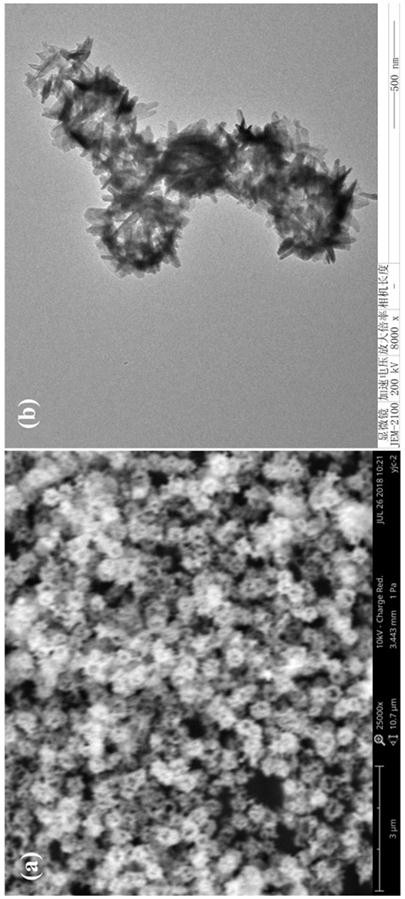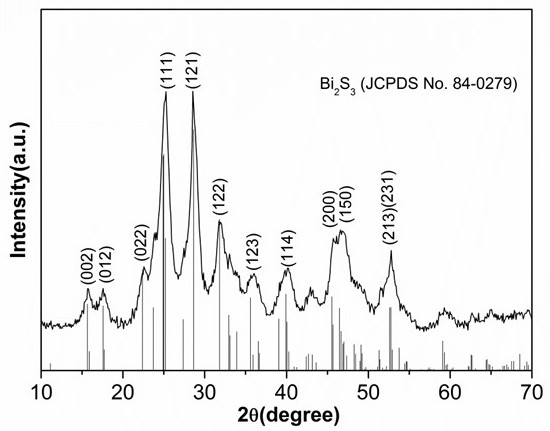Preparation method of near-infrared light-enriched cysteine-modified bismuth sulfide hollow spheres and its application in photothermal therapy and drug controlled release
A technology of cysteine and near-infrared light, which is applied in the fields of biomedical technology and nanomaterial science, can solve the problems of poor biocompatibility of materials, low photothermal conversion efficiency, and small drug loading, and achieve the purpose of increasing adsorption sites , improve the light-to-heat conversion efficiency, and the effect of less equipment
- Summary
- Abstract
- Description
- Claims
- Application Information
AI Technical Summary
Problems solved by technology
Method used
Image
Examples
Embodiment 1
[0035] (1) Preparation of bismuth composite microspheres: 60 mL ethanol-glycerol mixed solution (V 乙醇 :V 甘油 =1:1) as a solvent, after magnetic stirring at room temperature for 0.5 hours, 1.4550 g Bi(NO 3 ) 3 • 5H 2 O, stir to completely dissolve the bismuth nitrate to form a clear solution. Then 0.5 g of polyvinylpyrrolidone (PVP) was added, and magnetic stirring was continued for 1 hour to obtain a mixed solution. The mixed solution was transferred to a 100 mL polytetrafluoroethylene-lined autoclave, sealed, and placed in an oven at a constant temperature of 160°C for 3 hours. Finally, the reactor was naturally cooled to room temperature, and the precipitate was collected by centrifugation, washed and dried to obtain bismuth complex microspheres (Gly-Bi-PVP).
[0036] (2) L-Cys / Bi 2 S 3 Synthesis of hollow spheres: Weigh 0.1 g of bismuth composite microspheres obtained in step (1) and disperse them in 10 mL of distilled water, then add 0.242 g of L-cysteine (L-Cys) a...
Embodiment 2
[0040] Embodiment 2 (comparative example)
[0041] L-Cys / Bi 2 S 3 Preparation of solid spheres: with 30 mL ethanol-glycerol mixed solution (V 乙醇 :V 甘油 =1:1) as a solvent, after magnetic stirring at room temperature for 0.5 hours, 1.4550 g Bi(NO 3 ) 3 • 5H 2 O, stir to completely dissolve the bismuth nitrate to form a clear solution A. Dissolve 0.5 g of L-cysteine in 30 mL of distilled water to form solution B. Slowly add B dropwise into solution A under magnetic stirring, and continue magnetic stirring for 1 hour. Transfer it to a 100 mL polytetrafluoroethylene-lined autoclave, seal it, and place it in an oven at a constant temperature of 160°C for 6 hours. Finally, the reactor was naturally cooled to room temperature, and the precipitate was collected by centrifugation, washed and dried to obtain L-Cys / Bi 2 S 3 Solid ball.
[0042] Figure 5 for L-Cys / Bi 2 S 3 UV-Vis-NIR diffuse reflectance spectra of hollow and solid sphere samples. As shown, in the visible ...
Embodiment 3
[0044] Example 3 (photothermal performance test)
[0045] L-Cys / Bi 2 S 3 Hollow sphere and solid sphere samples were prepared into 500 µg / mL aqueous solution, and 2 mL each was placed in a cuvette. Put it at an optical power density of 1 W / cm 2 The 808 nm near-infrared light was irradiated, and the temperature change of the solution was monitored with an electronic sensing thermocouple thermometer. The result is as Figure 7 As shown, L-Cys / Bi 2 S 3 The hollow sphere can heat up rapidly under the irradiation of the laser, compared to the L-Cys / Bi 2 S 3 For solid spheres, L-Cys / Bi 2 S 3 Hollow spheres have high light-to-heat conversion capabilities.
[0046] Mix 2 mL of distilled water and 500 µg / mL of L-Cys / Bi 2 S 3 The hollow sphere aqueous solution was irradiated with laser light for 10 min, and then the laser was turned off to cool down to room temperature naturally. The temperature change during the recording period was recorded by a thermocouple, and the tempe...
PUM
| Property | Measurement | Unit |
|---|---|---|
| particle size | aaaaa | aaaaa |
| diameter | aaaaa | aaaaa |
| specific surface area | aaaaa | aaaaa |
Abstract
Description
Claims
Application Information
 Login to View More
Login to View More - R&D Engineer
- R&D Manager
- IP Professional
- Industry Leading Data Capabilities
- Powerful AI technology
- Patent DNA Extraction
Browse by: Latest US Patents, China's latest patents, Technical Efficacy Thesaurus, Application Domain, Technology Topic, Popular Technical Reports.
© 2024 PatSnap. All rights reserved.Legal|Privacy policy|Modern Slavery Act Transparency Statement|Sitemap|About US| Contact US: help@patsnap.com










